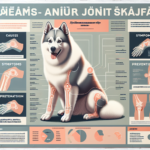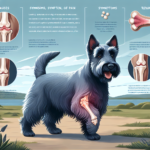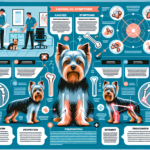Finnish Lapphund Joint Pain: Causes, Symptoms, Prevention, and Treatment

Introduction
The Finnish Lapphund is a versatile and resilient breed, known for its friendly demeanor and striking appearance. Originating from the northern regions of Finland, this breed was traditionally used by the Sami people for herding reindeer. Finnish Lapphunds are medium-sized dogs with a thick double coat, erect ears, and a distinctive curled tail. They are highly intelligent, trainable, and possess a strong work ethic, making them excellent companions for active families.
Like many breeds, Finnish Lapphunds are prone to certain health issues, with joint pain being a significant concern. Joint health is crucial for maintaining the breed’s mobility and overall quality of life. Understanding the causes, symptoms, prevention, and treatment of joint pain in Finnish Lapphunds can help owners ensure their pets lead healthy, active lives.
Breed-Specific Joint Pain Risks
Genetic Predisposition
Finnish Lapphunds, like many other breeds, have a genetic predisposition to joint-related issues. Hip dysplasia, a condition where the hip joint doesn’t fit properly into the hip socket, is relatively common in this breed. Elbow dysplasia, where the elbow joint is malformed, can also occur. Both conditions can lead to arthritis and chronic pain if not addressed early.
Age-Related Risks
As Finnish Lapphunds age, the risk of developing joint pain increases. While younger dogs may show few signs of joint issues, older dogs often experience stiffness, reduced mobility, and discomfort. Owners should be particularly vigilant as their dogs approach middle age, typically around 5-7 years, as this is when joint problems may start to manifest.
Activity Level and Joint Stress
Finnish Lapphunds are active and energetic dogs that thrive on physical activity. However, their high activity levels can sometimes contribute to joint stress, especially if they engage in high-impact activities like jumping or running on hard surfaces. While exercise is essential for their overall health, it’s important to balance activity with rest to prevent overexertion and joint damage.
Common Symptoms of Joint Pain in Finnish Lapphunds
General Symptoms
- Limping or favoring one leg
- Stiffness, especially after rest or sleep
- Reluctance to climb stairs or jump
- Decreased activity or playfulness
- Visible discomfort or pain when touched
- Swelling around the joints
Breed-Specific Symptoms
In Finnish Lapphunds, joint pain may also manifest as a reluctance to engage in herding or other instinctual activities. Owners may notice their dogs becoming less enthusiastic about tasks they previously enjoyed. Additionally, the breed’s thick coat can sometimes mask swelling, making it essential to observe changes in behavior closely.
When to Consult a Vet
If you notice any of the above symptoms in your Finnish Lapphund, it’s crucial to consult a veterinarian promptly. Early diagnosis and intervention can significantly improve the prognosis and quality of life for dogs with joint pain. Regular veterinary check-ups are also essential for monitoring joint health and catching issues early.
Preventive Measures for Joint Health
Exercise Recommendations
Regular, moderate exercise is key to maintaining joint health in Finnish Lapphunds. Activities like walking, swimming, and controlled play are excellent options. Avoid high-impact exercises that involve jumping or sudden stops and starts. Consistent, low-impact exercise helps keep joints flexible and muscles strong, reducing the risk of injury.
Dietary Suggestions
A balanced diet rich in essential nutrients supports joint health. Look for dog foods that contain glucosamine and chondroitin, which help maintain cartilage. Omega-3 fatty acids, found in fish oil supplements, can reduce inflammation and support joint function. Always consult your veterinarian before adding supplements to your dog’s diet.
Weight Management
Maintaining a healthy weight is crucial for reducing joint stress. Overweight dogs are more prone to joint issues due to the extra load on their joints. Monitor your Finnish Lapphund’s weight and adjust their diet and exercise routine as needed to keep them at an optimal weight. Your veterinarian can provide specific guidelines based on your dog’s age, size, and activity level.
Early Screening and Monitoring
Regular veterinary check-ups and early screening for joint issues can help catch problems before they become severe. X-rays and other diagnostic tools can identify conditions like hip or elbow dysplasia early on. Early intervention, including lifestyle changes and medical treatments, can significantly improve outcomes for dogs with joint issues.
Treatment Options for Joint Pain
Non-Surgical Treatments
Non-surgical treatments for joint pain in Finnish Lapphunds include medications, physical therapy, and lifestyle adjustments. Anti-inflammatory drugs and pain relievers can help manage symptoms. Physical therapy, including exercises and massage, can improve joint function and reduce pain. Lifestyle adjustments, such as providing a comfortable bed and avoiding stairs, can also make a significant difference.
Surgical Options
In severe cases, surgical intervention may be necessary. Common surgeries for joint issues include hip replacement, arthroscopy, and corrective osteotomy. These procedures can significantly improve mobility and reduce pain, but they come with risks and require a recovery period. Consult with a veterinary orthopedic specialist to determine the best course of action for your dog.
Alternative Therapies
Alternative therapies like acupuncture, hydrotherapy, and massage can complement traditional treatments. Acupuncture can help reduce pain and inflammation, while hydrotherapy provides low-impact exercise that strengthens muscles without stressing joints. Regular massage can improve circulation and reduce muscle tension, providing relief for dogs with joint pain.
Lifestyle and Management Tips
Daily Care Routine
A consistent daily care routine can help manage joint pain in Finnish Lapphunds. Start with a gentle morning walk to loosen stiff joints, followed by a balanced meal with joint-supporting supplements. Incorporate short, low-impact play sessions throughout the day, and provide a comfortable, supportive bed for rest. Regular grooming can also help you monitor for any changes in your dog’s condition.
Modifying the Home Environment
Making your home more comfortable for a dog with joint pain can significantly improve their quality of life. Consider installing ramps to help your dog navigate stairs and get onto furniture. Provide orthopedic beds that offer better support for aching joints. Ensure that food and water bowls are at a comfortable height to reduce strain on the neck and joints.
Long-Term Management
Long-term management of joint pain involves regular veterinary check-ups, consistent exercise, and a balanced diet. Monitor your dog’s condition closely and adjust their care routine as needed. Stay informed about new treatments and therapies that may benefit your dog. With proper management, Finnish Lapphunds can lead active, happy lives despite joint pain.
FAQs About Finnish Lapphunds and Joint Pain
What are the early signs of joint pain in Finnish Lapphunds?
Early signs of joint pain include limping, stiffness, reluctance to move, and decreased activity levels. If you notice any of these symptoms, consult your veterinarian for a thorough examination.
Can joint pain in Finnish Lapphunds be prevented?
While genetic predispositions can’t be entirely prevented, maintaining a healthy weight, providing regular low-impact exercise, and feeding a balanced diet with joint-supporting supplements can significantly reduce the risk of joint pain.
Are there specific exercises that are better for Finnish Lapphunds with joint pain?
Yes, low-impact exercises like walking, swimming, and controlled play are ideal for Finnish Lapphunds with joint pain. Avoid high-impact activities that can stress the joints.
What dietary supplements are beneficial for joint health in Finnish Lapphunds?
Supplements containing glucosamine, chondroitin, and omega-3 fatty acids are beneficial for joint health. Always consult your veterinarian before adding supplements to your dog’s diet.
When should I consider surgery for my Finnish Lapphund’s joint pain?
Surgery should be considered when non-surgical treatments are no longer effective, and your dog is experiencing significant pain and reduced mobility. Consult with a veterinary orthopedic specialist to discuss the best options for your dog.
Conclusion
Joint pain is a common issue in Finnish Lapphunds, but with proper care and management, it can be effectively addressed. Understanding the causes, symptoms, prevention, and treatment options is crucial for maintaining your dog’s joint health. Regular veterinary check-ups, a balanced diet, appropriate exercise, and early intervention can make a significant difference in your dog’s quality of life. By taking proactive measures, you can help ensure that your Finnish Lapphund remains active, happy, and healthy for years to come.


